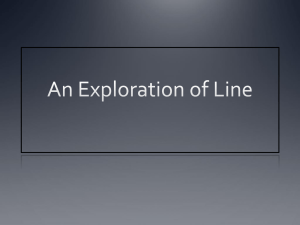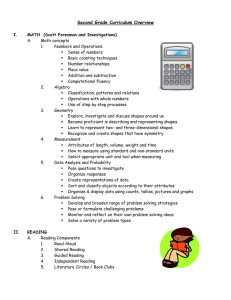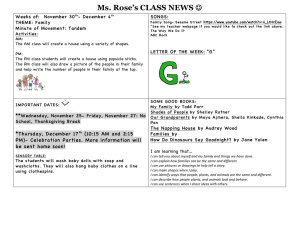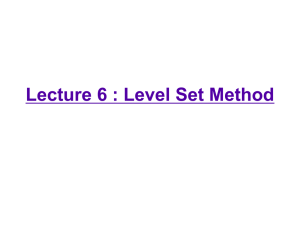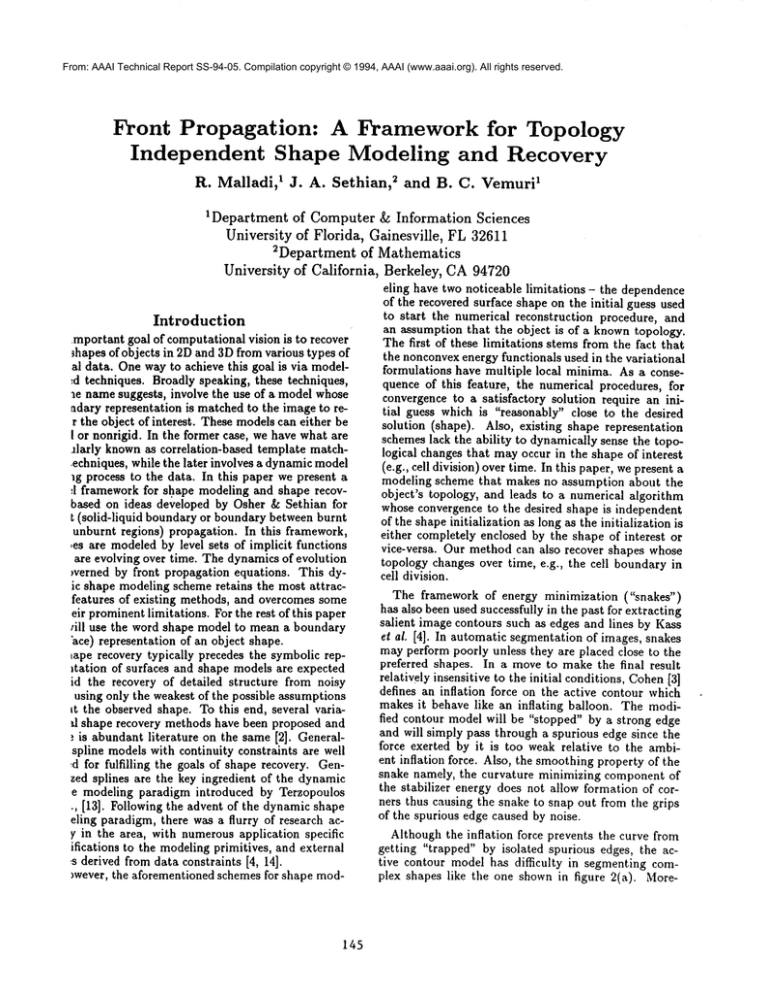
From: AAAI Technical Report SS-94-05. Compilation copyright © 1994, AAAI (www.aaai.org). All rights reserved.
Front Propagation:
A Framework for Topology
Independent
Shape Modeling and Recovery
R. Malladi, l J. A. Sethian, 2 1and B. C. Vemuri
1Departmentof Computer& Information Sciences
University of Florida, Gainesville, FL32611
2Department of Mathematics
University of California, Berkeley, CA94720
Introduction
mportant goal of computational vision is to recover
3hapes of objects in 2D and 3D from various types of
al data. One way to achieve this goal is via model:d techniques. Broadly speaking, these techniques,
~e namesuggests, involve the use of a model whose
adary representation is matchedto the image to rer the object of interest. These models can either be
I or nonrigid. In the former case, we have what are
Jlarly knownas correlation-based template match.echniques, while the later involves a dynamicmodel
lg process to the data. In this paper we present a
~1 framework for shape modeling and shape recovbased on ideas developed by Osher ~ Sethian for
t (solid-liquid boundary or boundary between burnt
unburnt regions) propagation. In this framework,
,es are modeledby level sets of implicit functions
are evolving over time. The dynamics of evolution
~verned by front propagation equations. This dyic shape modeling scheme retains the most attracfeatures of existing methods, and overcomes some
eir prominentlimitations. For the rest of this paper
lill use the word shape model to mean a boundary
"ace) representation of an object shape.
tape recovery typically precedes the symbolic repltation of surfaces and shape models are expected
id the recovery of detailed structure from noisy
using only the weakest of the possible assumptions
it the observed shape. To this end, several variafl shape recovery methods have been proposed and
; is abundant literature on the same [2]. Generalspline models with continuity constraints are well
d for fulfilling the goals of shape recovery. Genzed splines are the key ingredient of the dynamic
e modeling paradigm introduced by Terzopoulos
., [13]. Following the advent of the dynamic shape
eling paradigm, there was a flurry of research acy in the area, with numerous application specific
ifications to the modelingprimitives, and external
.s derived from data constraints [4, 14].
)wever, the aforementioned schemes for shape mod-
145
cling have two noticeable limitations- the dependence
of the recovered surface shape on the initial guess used
to start the numerical reconstruction procedure, and
an assumption that the object is of a knowntopology.
The first of these limitations stems from the fact that
the nonconvexenergy functionals used in the variational
formulations have multiple local minima. As a consequence of this feature, the numerical procedures, for
convergence to a satisfactory solution require an initim guess which is "reasonably" close to the desired
solution (shape). Also, existing shape representation
schemes lack the ability to dynamically sense the topological changes that may occur in the shape of interest
(e.g., cell division) over time. In this paper, we present
modeling scheme that makes no assumption about the
object’s topology, and leads to a numerical algorithm
whose convergence to the desired shape is independent
of the shape initialization as long as the initialization is
either completely enclosed by the shape of interest or
vice-versa. Our method can also recover shapes whose
topology changes over time, e.g., the cell boundary in
cell division.
The framework of energy minimization ("snakes")
has also been used successfully in the past for extracting
salient image contours such as edges and lines by Kass
et al. [4]. In automatic segmentation of images, snakes
mayperform poorly unless they are placed close to the
preferred shapes. In a move to make the final result
relatively insensitive to the initial conditions, Cohen[3]
defines aa inflation force on the active contour which
makes it behave like an inflating balloon. The modified contour model will be "stopped" by a strong edge
and will simply pass through a spurious edge since the
force exerted by it is too weak relative to the ambient inflation force. Also, the smoothing property of the
snake namely, the curvature minimizing component of
the stabilizer energy does not allow formation of corners thus causing the snake to snap out from the grips
of the spurious edge caused by noise.
Although the inflation force prevents the curve from
getting "trapped" by isolated spurious edges, the active contour model has difficulty in segmenting complex shapes like the one shown in figure 2(a). More-
over, despite a good’ initialization, the active contour
model, due to its arc-length and curvature minimization properties, cannot be forced to extrude through
any significant protrusions that a shape may possess.
So the problem is one of accurately modeling bifurcations and protrusions in complex structures. Wepropose a dynamic shape modeling method that will start
with a single instance of the model and will automatically "sprout" branches during the evolutionary process. Thus, in our framework of modeling, objects are
perceived as being made of a single primitive (front)
which can evolve into complicated shapes rather than
the view of different parts being glued together to form
a complicated object.
Most existing surface modeling techniques require
that the topology of the object be known before the
shape recovery can commence. However, it is not always possible to specify the topology of an object prior
to its recovery. As a result, most existing shape recovery
schemes in vision literature make strong assumptions
about the object topology. Unknowntopology is an
important concern in object tracking and motion detection applications where the positions of object boundaries are tracked in a time sequence of images. During
their evolution, these closed contours may change connectivity and split, thereby undergoing a topological
transformation (eg., in cell division). A heuristic criterion for splitting and merging of curves in 2D which is
based on monitoring deformation energies of points on
the elastic curve has been discussed in [9].
In the context of static problems, more recently, particle systems have been used to model surfaces of arbitrary topology [12]. Smoothness and continuity constraints are imposed by subjecting the particle system
to interaction potentials which locally prefer planar or
spherical arrangement. Particles can be added and
deleted dynamically to enlarge and trim the surface respectively, while the system dynamicsstrive continually
to organize the particles into smooth shapes. The result
is a versatile methodwith applications in surface fitting
to sparse data and 3D medical image segmentation.
The frameworkdescribed in this paper can be applied
to static as well as dynamicsituations, where no a prior/ assumption about the object’s topology is made. A
single instance of our model, when presented with an
image having more than one shape of interest, has the
ability to split freely to represent each shape [6, 7]. We
have shownthat by using our approach, it is also possible to extract the bounding contours of shapes wi~h
holes in a seamless fashion [7]. Shape recovery from 3D
images is also possible as shownin [7].
Outline of the Solution
In this subsection we briefly outline our shape modeling and recovery scheme. This method is inspired by
ideas first introduced in Osher & Sethian [10, 8, 11]
to model propagating fronts with curvature-dependent
speeds. Two such examples are flame propagation and
146
crystal growth, in which the speed of the moving interface normal to itself depends on transport terms modified by the local curvature. The challenge in these problems is to devise numerical schemes for the equations
of the propagating front which will accurately approximate these highly unstable physical phenomena. In [10]
it was shownthat direct parameterization of the moving
front maybe unstable since it relies on local properties
of the solution. In contrast, a method which preserves
the global properties of the motion is sought. Osher &
Sethian [8] achieve this by viewing the propagating surface as a specific level set of a higher-dimensionalfunction. The equation of motion for this function is reminiscent of an initial valued "Hamilton-Jacobi" equation
with a parabolic right-hand side and is closely related
to a viscous hyperbolic conservation law.
In our work, we adopt these leve!set techniques to the
problem of shape recovery. To isolate a shape from its
background, we first consider a closed, nonintersecting,
initial hypersurface placed inside (or outside) it. Following the above level set approach, this hypersurface is
then made to flow along its gradient field with a speed
F(K), where K is the curvature of the hypersurface. As
in [8, 10, 11], we adopt a global approach and view the
(N - 1) dimensional moving surface as a level set of a
time-dependent function ¢ of N space dimensions. The
equations of motion written for this higher dimensional
function are then amenable to stable entropy-satisfying
numerical schemes designed to approximate hyperbolic
conservation laws. Topological changes can be handled
naturally in this approach, since a particular level set
{¢ = 0} of the function ¢ need not be simply connected. However, there are two problems that need to
be surmounted before we can use this design for shape
recovery. First, it is required that we stop the hypersurface in the neighborhood of the desired shape. We
do this by synthesizing a speed term from the image
data. Secondly, we have to construct an extension of
this speed function to other level sets {¢ = C} in order
to give a consistent meaning to the image-based speed
term at all points in the image. In the following sections
we outline a possible solution to these problems.
Wenote that this work on interface motion and hyperbolic conservation laws as discussed in [8], has been
applied in the area of computervision for shape characterization by Kimia et al. [5], who unify manydiverse
aspects of shape by defining a continuum of shapes (reaction/diffusion space), which places shapes within
neighborhood of other similar shapes. This leads to a
hierarchical description of a shape which is suitable for
its recognition. The key distinguishing feature of our
work from that. of Kimia et al., is that they assume tile
boundary of the object shape to be known, while we
recover it from image data. In other words, they show
that by evolving a knownshape boundary, explicit clues
can be derived towards the goal of developing a hierarchical shape description. In contrast, we start with
an arbitrary function ¢ and recover complex shapes by
,pagating it along its gradient field.
[’he dynamicsof the front is given by,
¢, + (FA + Fx) ] V¢ I=
(1)
tere, FAis referred to as the advection term and is a
ed of the front expansion or contraction analogous
~he inflation force on snakes in [3]. FI is the speed
n synthesized from image data and is made to equal
he negative of FA near large image gradients thereby
’ing the propagating front to stop near edges in an
tge. F~ is called an extension of FI to points away
n the boundary 7(t), i.e. at points (x,y) E
}), and is equal to Fr on "r(t). Weintroduce a fast
aerical technique for solving this governing dynamic
ation of the propagating front. Our new algorithm
loits the fact that the front, which is a particular
~1 set {¢ - 0} of a higher dimensional function, can
tdvanced by updating the function ¢ at a small set of
~ts. This schemeis an alternative to updating the ¢
:tion at all the points in the computational domain
The set of points at which the update procedure
pplied belong to a narrow band lying on either side
he level set {¢ - 0}. Since the narrow-bandupdate
tegy involves only a fraction of the total numberof
its, a significant saving in time is realized, making
methoda very attractive alternative to other shape
,very schemes. A complete discussion of the narrowd techniques for interface propagation may be found
t].
L summary, we present a novel scheme for shape
leling which can be used in both computer vision
.pc recovery from images) and computer graphics
.pc synthesis) applications. Given the reconstructed
)e, our approach can also be extended to decipher
constituent part structure for high-level processing
Wenow present two example applications of shape
very with the propagating front in medical image
~. In figure 1, we depict the front initialization inthe shape of interest. Note that the front must be
alized either completely inside or outside the shape
tterest. In this example,the choice of inside initialon is obvious since the outside contains other meanal boundaries belonging to shapes that are not of
lary interest.
Narrow-band computation was done
¯ 128 x 128 grid - the front was made to propagate
¯ speed F = ~:1(-1.0 - 0.025K) and the time step
¯ as set to 0.0005. ~b was recomputed once every
ime steps. Note that the final recovered shape in
vas obtained after the front overshot all the spuriedges present inside the shape of interest (see (b)).
feature is a consequence of the eK component in
speed which diffuses regions of high curvature on
t’ront and forces it to attain a smoothshape.
the second experiment we recover the complicated
:ture of the branch of an arterial tree. The real
,~e has been obtained by clipping a portion of a
;al subtraction angiogram. This is an example of
ape with extended branches or significant protru-
147
sions. In this experiment we compare the performance
of our scheme with the active contour model (’snakes’)
to bring the limitations of the later into focus. In an attempt to recover the arterial tree, we tried three distinct
’snake’ initializations, one closer to the final shape than
the preceding. In figure 2(a), we show one such snake
initialization. In all three cases, despite good initializations, the snake model is unable to recover arterial
shape (see figure 2(b)). This is due to the existence
multiple local minima in the (nonconvex) energy functional which the numerical procedure explicitly minimizes. Also, the snake prefers regular shapes because
shapes with protrusions have very high deformation energies. Wenow apply our level set algorithm to reconstruct the same shape. After initialization in figure
2(d), the front is made to propagate in the normal direction. Weemploy the narrow-band updation scheme
with a band width of 6 = 0.075 to movethe front. It can
be seen that the front literally "flows" into the branches
and 2(i) completely recovers the complex shape. The
advantages of our scheme over the ’snake’ model are
quite apparent from this example. Since our front advancement process does not involve optimization of any
quantity, the shape recovery results we obtain do not require an initialization close to the final desired shape. In
addition, a single instance of our shape model "sprouts"
branches and recovers all the connected components of
a given shape.
Concluding
remarks
In this paper we presented a new shape modeling
scheme. Our approach while retaining the desirable
features of existing methods for shape modeling, overcomes some of their deficiencies. Weadopt the level
set based techniques - of Osher & Sethian [8] for front
propagation - to the problem of shape recovery. In this
approach, unlike in the ’snakes’ method, a good shape
initialization
is not needed for shape recovery so long
as the initialization is either enclosed by the shape of
interest or vice-versa. Moreover, our scheme makes no
a priori assumption about the object’s topology. Other
salient features of our shape modeling scheme include
its ability to split and merge freely without any additional bookkeeping during the evolutionary process,
and its easy extensibility to higher dimensions. Our future research efforts will be focussed on extending this
method to other application domains.
References
[1] D. Adalsteinsson and J. A. Sethian, "A narrowband approach to level set techniques for propagating interfaces," LBLReport, Oct. 1993.
[2] R. M. Bolle and B. C. Vemuri, "On threedimensional surface reconstruction
methods,"
IEEE Trans. on Pattern Analysis and Machine Intelligence, vol. PAMI13, No. 1, pp. 1-13, 1991.
[3] L. D. Cohen, "On Active Contour Models and
Balloons," Computer Vision, Graphics, and Image Processing, Vol. 53, No. 2, pp. 211-218, March
1991.
[4] M. Kass, A. Witkin, and D. Terzopoulos, "Snakes:
Active Contour Models," International Journal of
Computer Vision, pp. 321-331, 1988.
[5] B. B. Kimia, A. R. Tannenbaum, and S. W.
Zucker, "Shapes, shocks, and deformations I: The
componentsof shape and reaction-diffusion space,"
to appear in International Journal of Computer
Vision, 1992.
[6] R. Malladi, J. A. Sethian, and B. C. Vemnri, "A
topology-independent shape modeling scheme," in
Proceedings of SPIE Conference on Geometric
Methods in Computer Vision II, San Diego, California, pp. 246-258, July 1993.
[7] R. Malladi, J. A. Sethian, and B. C. Vemuri,
"Shape modeling with front propagation: A level
set approach," Center for Pure and Applied Mathematics, Report PAM-589, Univ. of California,
Berkeley, August 1993; also to appear in IEEE
Trans. on Pattern Analysis and Machine Intel..
[8] S. Osher and J. A. Sethian, "Fronts propagating with curvature dependent speed: Algorithms
based on Hamilton-Jacobi formulation," Journal of
Computational Physics, Vol. 79, pp. 12-49, 1988.
in ac[9] R. Samadani, "Changes in connectivity
tive contour models," Proceedings of the Workshop
on Visual Motion, pp. 337-343, Irvine California,
March 1989.
[10] J. A. Sethian, "Curvature and the evolution of
fronts," Commnn.in Mathematical Physics, Vol.
101, pp. 487-499, 1985.
[11] J. A. Sethian, "Numerical algorithms for propagating interfaces: Hamilton-Jacobi equations and
conservation laws," Journal of Differential Geom.etry, Vol. 31, pp. 131-161, 1990.
[12] R. Szeliski and D. Tonnesen, "Surface modeling
with oriented particle systems," Computer Graphics SIGGRAPH,Vol. 26, No. 2, pp. 185-194, July
1992.
[13] D. Terzopoulos, A. Witkin, and M. Kass, "Constraints
on deformable models: Recovering 3D
shape and nonrigid motion," Artificial Intelligence,
36, pp. 91-123, 1988.
[14] B. C. Venmri and R. Mailadi, "Constructing intrinsic parameters with active models for invariant
surface reconstruction,"
IEEE Trans. on Pattern
Analysis and MachineIntelligence, Vol. 15, No. 7,
pp. 668-681, July 1993.
(c)
(d)
Figure 1: Recovery of the stomach shape from a CT
image of an abdominal section. (a) Initialization,
(b)
image-based speed term, (c) shape after 450 iterations
and (d) after 575 iterations.
(~)
m
(b)
m
(c)
(d)
Figure 2: Reconstruction of a shape with "significant"
protrusions: an arterial tree structure. An unsuccessful
attempt to recover the shape using the ’snake’ model
initialized in (a) is shownin (b). (c) Initialized
and (d) recovered shape after 391 iterations.
148


